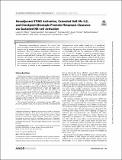Neoadjuvant STING Activation, Extended Half-life IL2, and Checkpoint Blockade Promote Metastasis Clearance via Sustained NK-cell Activation
Author(s)
Milling, Lauren E; Garafola, Daniel; Agarwal, Yash; Wu, Shengwei; Thomas, Ayush; Donahue, Nathan; Adams, Josetta; Thai, Nikki; Suh, Heikyung; Irvine, Darrell J; ... Show more Show less
DownloadPublished version (1.182Mb)
Publisher with Creative Commons License
Publisher with Creative Commons License
Creative Commons Attribution
Terms of use
Metadata
Show full item recordAbstract
<jats:title>Abstract</jats:title>
<jats:sec>
<jats:title />
<jats:p>Combination immunotherapy treatments that recruit both innate and adaptive immunity have the potential to increase cancer response rates by engaging a more complete repertoire of effector mechanisms. Here, we combined intratumoral STimulator of INterferon Genes (STING) agonist therapy with systemically injected extended half-life IL2 and anti–PD-1 checkpoint blockade (hereafter CIP therapy) to drive innate and adaptive antitumor immunity in models of triple-negative breast cancer. Unlike treatment with the individual components, this trivalent immunotherapy halted primary tumor progression and led to long-term remission for a majority of animals in two spontaneously metastasizing orthotopic breast tumor models, though only as a neoadjuvant therapy but not adjuvant therapy. CIP therapy induced antitumor T-cell responses, but protection from metastatic relapse depended on natural killer (NK) cells. The combination of STING agonists with IL2/anti–PD-1 synergized to stimulate sustained granzyme and cytokine expression by lung-infiltrating NK cells. Type I IFNs generated as a result of STING agonism, combined with IL2, acted in a positive-feedback loop by enhancing the expression of IFNAR-1 and CD25 on lung NK cells. These results suggest that NK cells can be therapeutically targeted to effectively eliminate tumor metastases.</jats:p>
<jats:p>See related Spotlight by Demaria, p. 3 .</jats:p>
</jats:sec>
Date issued
2022Department
Massachusetts Institute of Technology. Department of Biological EngineeringJournal
Cancer Immunology Research
Publisher
American Association for Cancer Research (AACR)
Citation
Milling, Lauren E, Garafola, Daniel, Agarwal, Yash, Wu, Shengwei, Thomas, Ayush et al. 2022. "Neoadjuvant STING Activation, Extended Half-life IL2, and Checkpoint Blockade Promote Metastasis Clearance via Sustained NK-cell Activation." Cancer Immunology Research, 10 (1).
Version: Final published version